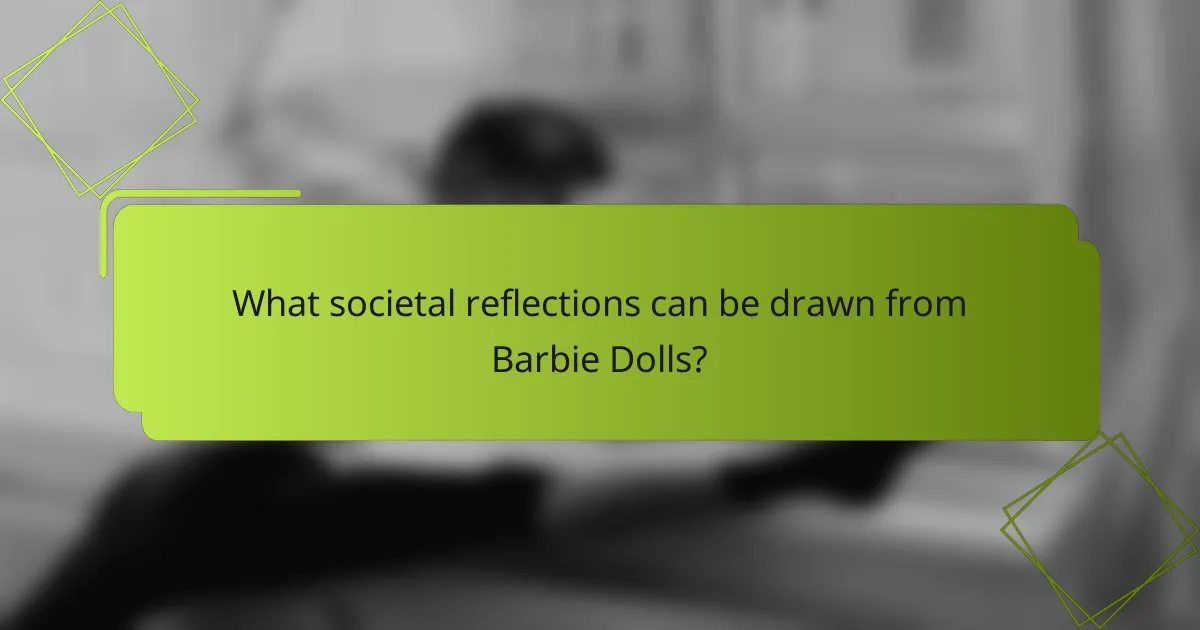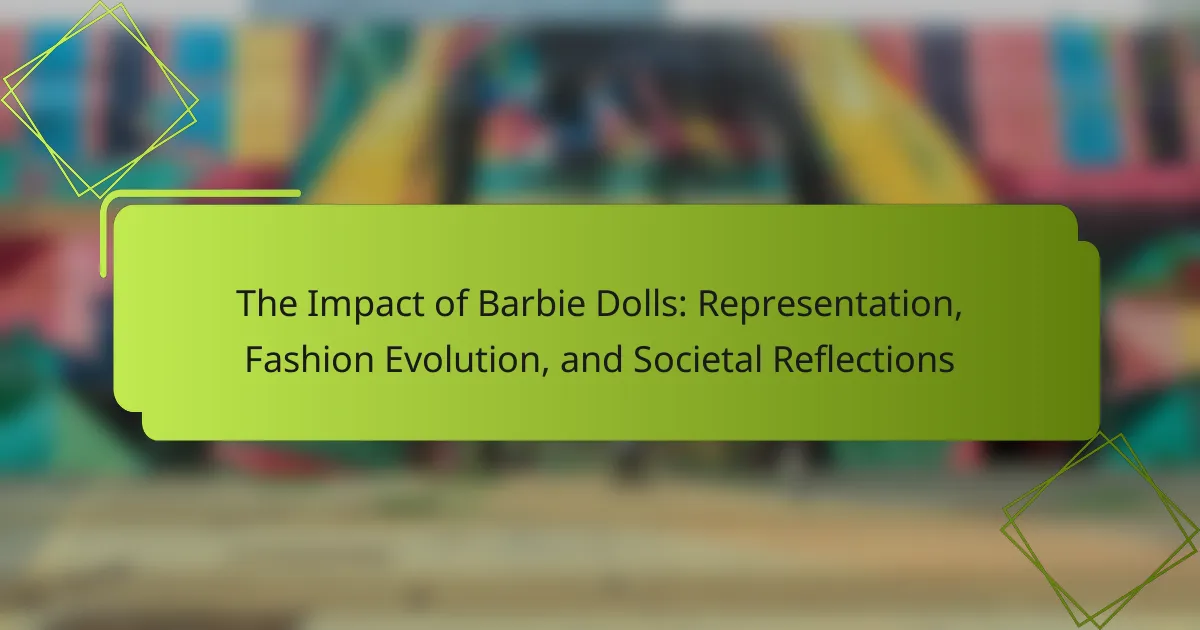
What is the Impact of Barbie Dolls?
Barbie dolls have a significant impact on cultural perceptions of gender and beauty. They serve as a reflection of societal norms and values throughout their history. Since their introduction in 1959, Barbie has evolved to represent diverse careers and body types. This evolution promotes the idea of empowerment among young girls. Research shows that Barbie dolls influence children’s aspirations and self-image. A study by the University of California found that exposure to Barbie can affect girls’ career aspirations. Additionally, Barbie’s representation of various cultures encourages inclusivity. Overall, Barbie dolls shape societal views on femininity and success.
How have Barbie Dolls evolved over time?
Barbie dolls have evolved significantly since their introduction in 1959. Initially, Barbie represented a traditional image of femininity with limited career options. Over the decades, Barbie has adopted various roles, including astronaut, doctor, and president, reflecting changing societal norms. In the 1980s, Barbie began to embrace diversity, introducing dolls of different ethnicities. The 2000s saw a focus on body positivity, leading to the release of curvy, tall, and petite dolls. In recent years, Barbie has collaborated with various brands and influencers to promote inclusivity. This evolution mirrors broader cultural shifts towards gender equality and representation in media. Barbie has also adapted to modern trends, incorporating technology and interactive features in new releases.
What historical events influenced the design of Barbie Dolls?
The design of Barbie dolls was influenced by several historical events. The 1950s post-war era emphasized consumerism and femininity. This context led to the creation of Barbie in 1959, reflecting contemporary fashion trends. The women’s liberation movement in the 1960s and 1970s introduced diverse roles for women. Barbie began to represent various careers, showcasing empowered female figures. The introduction of multicultural dolls in the 1980s responded to growing diversity in society. Additionally, the rise of feminism in the 1990s prompted Barbie to embrace more progressive themes. Each of these events shaped Barbie’s evolution, making her a reflection of societal changes.
How has Barbie’s appearance changed in response to societal trends?
Barbie’s appearance has evolved significantly to reflect changing societal trends. Initially, Barbie represented a narrow standard of beauty with unrealistic body proportions. Over the decades, Mattel has introduced diverse body types, skin tones, and hairstyles. In 2016, Barbie’s Fashionistas line included curvy, petite, and tall dolls. This shift aligns with increasing awareness of body positivity and inclusivity. The brand has also embraced contemporary fashion trends, showcasing various styles that resonate with modern consumers. For instance, Barbie has featured outfits inspired by popular culture and social movements. These changes demonstrate Barbie’s adaptability to societal expectations and the importance of representation in toys.
What role do Barbie Dolls play in representation?
Barbie dolls play a significant role in representation by reflecting and shaping societal norms and ideals. They have evolved to represent diverse body types, ethnicities, and careers. This evolution allows children to see themselves in various roles and identities. For example, Barbie introduced dolls of different skin tones in the 1980s. In recent years, Barbie has included dolls with disabilities and various professions. This inclusivity aims to promote acceptance and understanding among children. Research indicates that representation in toys can influence children’s self-esteem and aspirations. Overall, Barbie dolls serve as a tool for both reflection and inspiration in societal representation.
How do Barbie Dolls reflect cultural diversity?
Barbie dolls reflect cultural diversity by representing various ethnicities, body types, and professions. Over the years, Barbie has introduced dolls with different skin tones, hair textures, and [censured] features. In 2016, the Barbie Fashionistas line expanded to include dolls of diverse body shapes, including curvy, tall, and petite. This initiative aimed to promote inclusivity and challenge traditional beauty standards. Additionally, Barbie has portrayed women in various careers, showcasing diverse roles in society. The introduction of dolls inspired by real-life figures from different cultures further enhances representation. These efforts align with broader societal movements towards inclusivity and acceptance.
What impact do Barbie Dolls have on gender representation?
Barbie Dolls have a significant impact on gender representation. They have historically portrayed various careers and roles, influencing perceptions of women’s capabilities. Barbie’s evolution reflects changing societal norms and expectations for women. Research shows that Barbie dolls can affect children’s career aspirations and self-image. A study by the University of California found that girls exposed to Barbie were less likely to see themselves in STEM careers. This indicates that while Barbie promotes diversity in roles, it can also reinforce stereotypes. The dolls’ representation of beauty standards can affect body image perceptions among young girls. Overall, Barbie Dolls serve as both a reflection and shaper of gender roles in society.

How do Barbie Dolls influence fashion trends?
Barbie dolls influence fashion trends by serving as a cultural icon that reflects and shapes societal styles. Since their introduction in 1959, Barbie has showcased various fashion trends, from high couture to everyday wear. Designers often draw inspiration from Barbie’s wardrobe for their collections. The doll has collaborated with numerous fashion houses, including Moschino and Versace. These collaborations create buzz and drive consumer interest in specific styles. Barbie’s diverse representation also encourages inclusivity in fashion. By promoting various body types and ethnicities, Barbie influences brands to adopt more inclusive practices. Market research shows that Barbie-related merchandise often sees increased sales during fashion collaborations. Overall, Barbie dolls play a significant role in both reflecting and influencing fashion trends globally.
What are the key fashion styles represented by Barbie Dolls?
Barbie Dolls represent a variety of key fashion styles. These styles include classic, modern, and themed outfits. Classic styles often showcase timeless fashion elements, such as evening gowns and tailored suits. Modern styles reflect contemporary trends, incorporating casual wear and athleisure. Themed outfits are inspired by specific professions, cultures, and events, such as holiday attire or career costumes. Over the years, Barbie has featured styles ranging from vintage 1950s looks to futuristic designs. The diversity of fashion styles highlights societal changes and evolving beauty standards. Barbie’s fashion evolution mirrors cultural trends and influences, making her a significant figure in fashion representation.
How have Barbie’s outfits changed with fashion movements?
Barbie’s outfits have evolved significantly alongside fashion movements over the decades. Initially, Barbie’s fashion in the 1950s reflected the classic styles of the era, featuring tailored dresses and elegant accessories. As the 1960s brought about the mod fashion movement, Barbie’s wardrobe included mini dresses and bold patterns. The 1970s introduced bohemian styles with flowy fabrics and earth tones, aligning with the cultural shifts of the time. In the 1980s, Barbie embraced vibrant colors and power suits, mirroring the rise of women’s empowerment in the workplace. The 1990s saw a return to casual styles, with Barbie sporting denim and sporty looks, reflecting the grunge movement. In the 2000s, Barbie’s fashion became more diverse, incorporating global influences and contemporary streetwear trends. Most recently, Barbie has embraced sustainable fashion, showcasing eco-friendly materials and designs that resonate with modern values. This progression illustrates how Barbie’s outfits not only mirror fashion trends but also reflect societal changes and cultural movements.
What collaborations have Barbie Dolls had with fashion designers?
Barbie Dolls have collaborated with numerous fashion designers over the years. Notable collaborations include Christian Dior, Versace, and Oscar de la Renta. These partnerships have resulted in unique and collectible fashion dolls. For instance, the Barbie x Moschino collection debuted in 2015, showcasing high-fashion designs. Another collaboration with Balmain featured a limited-edition Barbie in 2015 as part of a runway show. In 2021, Barbie partnered with designer Jeremy Scott, releasing a doll inspired by his runway collections. Each collaboration emphasizes Barbie’s influence in the fashion industry and her role in promoting diverse styles. These partnerships reflect evolving fashion trends and cultural shifts.
In what ways do Barbie Dolls impact children’s perceptions of fashion?
Barbie Dolls significantly influence children’s perceptions of fashion. They introduce diverse styles and trends through various outfits and accessories. This exposure shapes children’s understanding of fashion choices and personal expression. Barbie’s evolving wardrobe reflects societal trends, teaching children about contemporary fashion. Studies show that children often emulate Barbie’s looks in their own play. This emulation fosters creativity and self-expression in their fashion choices. Additionally, Barbie’s representation of different careers and lifestyles broadens children’s views on fashion’s role in identity. By showcasing various cultures, Barbie promotes inclusivity in fashion perceptions among children.
How do children interpret Barbie’s fashion choices?
Children interpret Barbie’s fashion choices as expressions of creativity and individuality. They often view Barbie’s diverse outfits as opportunities to explore different styles and roles. This interpretation is influenced by Barbie’s ability to embody various professions and lifestyles through her clothing. Research shows that children associate Barbie’s fashion with empowerment and self-expression. For instance, a study by the University of Southern California found that girls who play with Barbie report higher levels of body confidence. Additionally, children often mimic Barbie’s fashion in their own play, reflecting their understanding of social norms and trends. This interaction helps shape their perceptions of beauty and identity.
What messages about beauty and style do Barbie Dolls convey?
Barbie Dolls convey messages about beauty and style that emphasize idealized femininity. They often represent a narrow standard of beauty characterized by unrealistic body proportions. This portrayal can influence perceptions of self-image among children. Barbie’s diverse range of careers promotes empowerment but still aligns with traditional beauty norms. The dolls reflect changing fashion trends, showcasing various styles over decades. Despite attempts at inclusivity, the core representation often remains Eurocentric. This can perpetuate stereotypes about beauty and desirability. Studies indicate that exposure to Barbie Dolls may affect children’s body image and aspirations.

What societal reflections can be drawn from Barbie Dolls?
Barbie Dolls reflect societal standards of beauty and gender roles. They have evolved to represent diverse body types, ethnicities, and careers. This evolution mirrors changing societal attitudes towards inclusivity and empowerment. For example, Barbie introduced dolls with different body shapes in 2016, addressing criticism about unrealistic body standards. The brand has also featured dolls in various professions, promoting the idea that women can pursue any career. Such representations challenge traditional gender norms and encourage young girls to aspire to diverse roles. Additionally, Barbie’s impact on fashion trends highlights the cultural significance of style and identity. Overall, Barbie Dolls serve as a cultural artifact that both influences and reflects societal values.
How do Barbie Dolls mirror societal values and norms?
Barbie dolls mirror societal values and norms by reflecting changing perceptions of beauty and gender roles. Initially, Barbie represented an idealized image of femininity in the 1950s. Over time, the brand evolved to include diverse body types, ethnicities, and careers. This shift aligns with broader societal movements toward inclusivity and empowerment. For instance, the introduction of dolls with different skin tones and body shapes occurred in response to growing awareness of diversity. Additionally, Barbie’s various careers symbolize women’s increasing presence in the workforce. Such representations influence children’s understanding of gender and societal expectations. The ongoing adaptations of Barbie demonstrate how cultural values shape and redefine identity and aspirations.
What criticisms have been directed at Barbie Dolls regarding body image?
Barbie Dolls have faced significant criticisms regarding body image. Critics argue that Barbie’s unrealistic proportions promote unhealthy beauty standards. Research indicates that the doll’s figure is unattainable for the average woman. For instance, Barbie’s measurements suggest a body mass index (BMI) that classifies her as underweight. This portrayal can lead to body dissatisfaction among young girls. Studies have shown that exposure to such dolls can negatively impact self-esteem. Furthermore, some argue that Barbie lacks diversity in body shapes and sizes. This limited representation can reinforce narrow definitions of beauty. Overall, these criticisms highlight concerns about the influence of Barbie on body image perceptions.
How have Barbie Dolls adapted to changing societal expectations?
Barbie Dolls have adapted to changing societal expectations by diversifying their representation and body types. Over the years, Barbie has introduced dolls with various skin tones, hairstyles, and body shapes. This shift reflects a broader societal push for inclusivity and representation in media and toys. For instance, in 2016, Mattel launched the “Fashionistas” line featuring dolls with curvy, tall, and petite body types. This line aimed to challenge traditional beauty standards. Additionally, Barbie has embraced careers and roles that reflect modern societal values, such as STEM professions and activism. This evolution aligns with growing expectations for toys to promote empowerment and diversity. As a result, Barbie Dolls have become more relatable to a wider audience, reinforcing positive messages about self-acceptance and individuality.
What lessons can we learn from the evolution of Barbie Dolls?
The evolution of Barbie Dolls teaches us about changing societal norms and values. Barbie’s design has shifted to reflect diversity and inclusivity over the decades. Initially, Barbie represented a narrow standard of beauty. The introduction of various body types and skin tones began in 2016. This shift indicates a growing recognition of different identities and experiences. Barbie also adapted to cultural trends and professions, showcasing women in diverse roles. For instance, Barbie has been a doctor, astronaut, and engineer. This evolution encourages young girls to envision themselves in various careers. Ultimately, Barbie’s evolution mirrors societal progress toward inclusivity and empowerment.
How can parents use Barbie Dolls to discuss representation and diversity?
Parents can use Barbie dolls to discuss representation and diversity by highlighting the various dolls that reflect different cultures, body types, and professions. Barbie has introduced dolls with different skin tones, hair textures, and disabilities, showcasing a broader spectrum of identities. This variety allows parents to initiate conversations about inclusivity and acceptance. For example, discussing the Barbie Fashionista line can help illustrate the importance of representation in toys. Parents can encourage children to explore the stories behind each doll, fostering understanding of diverse experiences. Engaging in role-play with the dolls can further enhance discussions about empathy and social issues. This approach not only promotes awareness but also empowers children to appreciate differences among individuals.
What are some best practices for engaging children with Barbie Dolls positively?
Engaging children with Barbie Dolls positively involves encouraging creativity and imagination. Allow children to create stories and scenarios using the dolls. This enhances their narrative skills and fosters creative play. Incorporate diverse Barbie Dolls to promote inclusivity and representation. This helps children understand and appreciate different cultures and body types.
Facilitate group play to enhance social skills. Children learn cooperation and communication by playing together. Set up themed playdates centered around Barbie Dolls. This can create a fun and engaging environment for children.
Encourage children to customize their dolls with outfits and accessories. This promotes self-expression and individuality. Provide resources like books or movies featuring Barbie that highlight positive messages. This can inspire children and broaden their understanding of the world.
The primary entity of this article is Barbie Dolls, which have significantly influenced cultural perceptions of gender, beauty, and fashion since their introduction in 1959. The article explores the evolution of Barbie, highlighting changes in representation, including diverse body types and career roles, as well as the impact on children’s aspirations and self-image. It discusses how Barbie reflects societal values and norms, including inclusivity and empowerment, while also addressing criticisms regarding body image. Additionally, the article examines Barbie’s role in shaping fashion trends and the lessons that can be drawn from her evolution in relation to representation and diversity.



